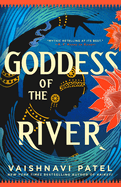
Vaishnavi Patel (Kaikeyi) tells the story of the Mahabharata through the dual perspectives of the goddess Ganga and her son Bhishma in Goddess of the River. The goddess Ganga--who appears only briefly at the beginning of the source text--remains an important character throughout this moving novel, which touches on themes of motherhood, love, duty, justice, pain, grief, guilt, and causality.
The narrative begins with Ganga's arrival on Earth in response to humanity's prayers, followed by her binding when other gods fear her "unbridled spirit"; her gradual appreciation of Earth's natural beauty and the godlings who care for it; and her horror at humanity's destruction of Earth. After a vengeful human curses Ganga and her beloved godlings to mortal form as mother and children, Ganga releases seven godlings by drowning them moments after birth, but her husband, the raja of Hastinapur, prevents her from killing her eighth godling child, who becomes Bhishma. Bhishma misunderstands Ganga's instructions, which were intended to save him from committing human crimes whose weight he would bear when returned to godling form, and he honors his oaths even when doing so negates the righteous choice. As a result, disputes about the rightful heir fester over two generations, and Hastinapur hurtles toward a "war to end all wars" between cousins. Humans grapple with the meanings of dharma and righteousness, and Ganga's stance on humanity softens as she begins to understand the complexity of the human condition.
Patel's lyrical style, especially in Ganga's voice, remains even through blood-soaked battle scenes, keeping the focus on ideas about the long sweep of history, both of humanity and the world. --Dainy Bernstein, freelance reviewer

